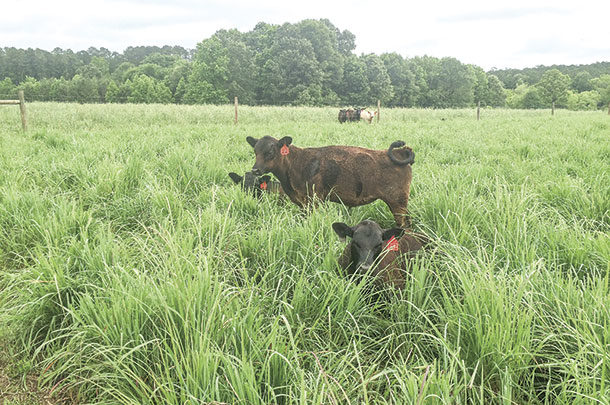The first of two purposes these species fill is the ability to create beneficial wildlife habitat for grassland birds, such as bobwhite quail and turkey, along with cover and structure for small mammals such as rabbits.
The second role NWSG can fill is their ability to provide a drought-tolerant, nutritious forage crop for grazing livestock. These species are highly regarded for their persistence in drier environments and are readily consumed in rangeland grazing systems in the Midwest, where stands are naturally occurring.
In the Southeast, however, these same NWSG species have been replaced with traditional forage crops such as bahiagrass and bermudagrass, due to their ease in establishment and their tolerance to close, frequent grazing.
NWSG species such as indiangrass, big bluestem and little bluestem once dominated areas of the South, such as the Black Belt Prairie in Mississippi and Alabama, and were major components in the understory of the longleaf pine ecosystem that once comprised nearly 60 million acres of the Coastal Plain ranging from east Texas to the Piedmonts of Virginia.
Federal policies regarding invasive species, conservation plantings and cost-share farm programs have generated enthusiasm in converting old pastures and hayground into rotational grazing systems comprised of NWSG. These lands could then serve a dual-purpose role: providing forage for livestock and wildlife habitat.
This surge of interest has initiated research designed to provide landowners with the tools necessary to make management decisions based on the use of NWSG as a forage in the Deep South. In this article, we will focus on research currently being conducted at the Coastal Plain Branch Experiment Station in Newton, Mississippi.
NWSG versus bahiagrass
In the central and southern portions of Mississippi, bahiagrass comprises a majority of the forage base for cow-calf operations. This species is drought-tolerant, easy to establish and can tolerate continuous close grazing with minimal inputs. However, this species provides little to no benefit to wildlife and is considered a maintenance grass for summer grazing, as nutritional values and intake produce less-than-desirable gains on growing cattle.
Average daily gain on bahiagrass pastures ranges from 0.75 to 1.2 pounds per day. In order to validate the use of NWSG for livestock producers, a grazing study was designed to compare bahiagrass with two NWSG treatments and to evaluate animal performance on stocker cattle. Stocker cattle were used in this experiment to measure weight gain over a given period of time, ultimately allowing producers to determine if retaining ownership of fall-born, weaned calves later into the summer is a profitable venture.
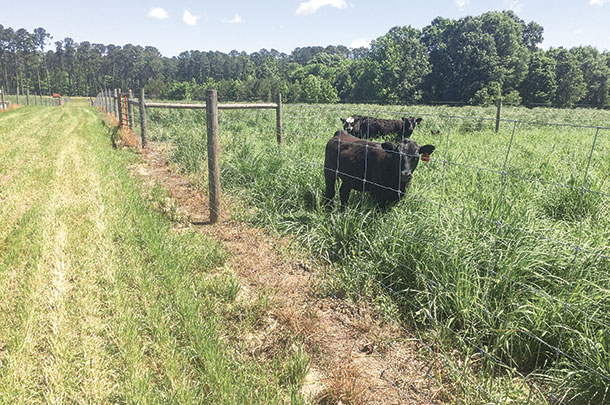
In the spring of 2015, three grass treatments (“Argentine” bahiagrass, big bluestem and NWSG mix comprised of indiangrass, big bluestem and little bluestem in a 6-to-3-to-1 ratio) were established in 2-acre paddocks. After a full year of establishment, the grazing trial began in the spring of 2016.
Commercial stocker cattle (500- to 600-pound steers) were grazed 84 days beginning on May 2 and ending July 26, 2016. Cattle were weighed every 24 days and forage dry matter (DM) and nutritive value were measured from samples collected from each paddock. The stocking rate for each paddock was roughly 1,000 pounds per acre (four steers per paddock).
All paddocks were fertilized according to soil-test recommendations, and each received 50 pounds of nitrogen per acre prior to grazing.
Results from 2016
Forage DM and nutritive value results will be discussed first. In terms of DM, the big bluestem and NWSG mix both produced greater amounts of DM compared to bahiagrass (Table 1).
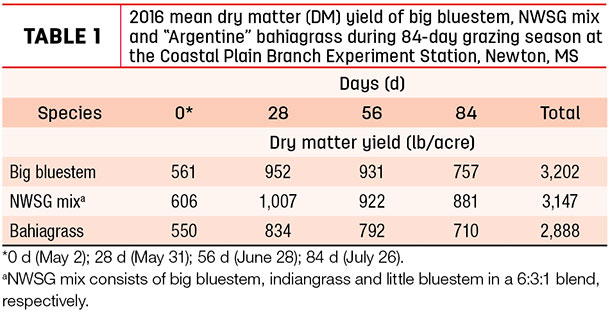
This is not that surprising, as NWSG typically produce a fair amount of biomass, especially as the season progresses and seedheads begin to form. Bahiagrass produces a majority of its biomass within 3 to 6 inches from the soil and does not have a tillering type of growth like NWSG.
In terms of nutritive value, however, bahiagrass outperforms, though minimally, the other two NWSG treatments (Figure 1).
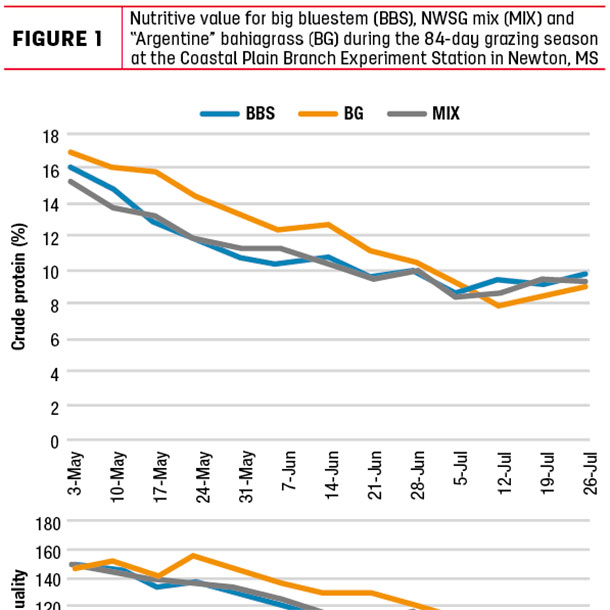
Crude protein, total digestible nutrients and relative forage quality were slightly greater for bahiagrass during each week for the entire 84-day grazing season. For all grass treatments, nutritive values declined below suggested levels required for stocker cattle to gain 2 pounds per day by mid- to late June.
Animal performance (i.e., weight gain) data told a different story (Table 2). As mentioned earlier, steers were weighed at 28, 56 and 84 days.
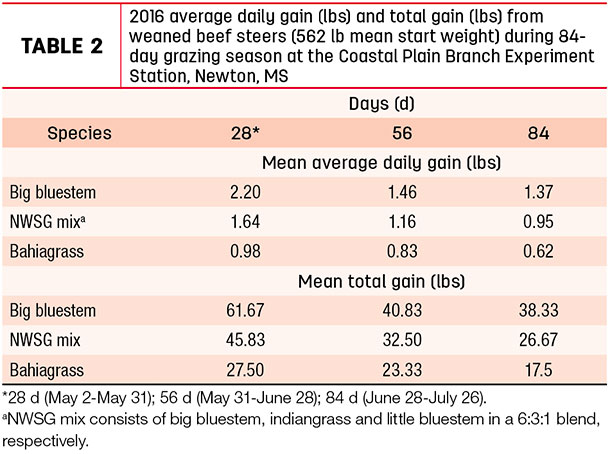
Average daily gain at the 28-day weigh-in showed gains above 2 pounds per head per day on the big bluestem treatment, at 2.2 pounds per head per day, followed by NWSG mix at 1.64 pounds per head per day and bahiagrass at 0.98 pound per head per day.
For the duration of the grazing period, bahiagrass average daily gain did not go above 0.98 pound per head per day. For the two NWSG treatments, gains remained above 1 pound per head per day for all weigh-ins except the 84-day NWSG mix, which was 0.95 pound per head per day.
Summary
In summary, NWSG are capable of producing greater than 2 pounds per head per day on stocker cattle during early season grazing. The grazing window for the first year of this study demonstrates the ability to add extra weight to growing cattle on a perennial forage before marketing. In a rotationally grazed system, this will enable producers to stockpile bahiagrass or bermudagrass pastures until later in the summer while grazing NWSG pastures earlier in the year.
This practice could then shift the grazing season later into the fall, thus diminishing the impact of possible drought during the drier months of the year. Once NWSG have been grazed out (around July 1), they can be allowed to go to seed and provide structural cover and nesting habitat for over-wintering birds and small mammals until the following grazing season.
From a cow-calf producer standpoint, NWSG forages provide ample quality forage for dry cows during the summer months. Grazing and soil fertility management are required for maximum productivity and stand longevity. A second year of this study will be conducted in the spring of 2017 to help validate the results of the first year. ![]()
PHOTOS: Calves grazing on native warm-season grasses. Photos provided by Brett Rushing.
J. Brett Rushing is the assistant research/extension professor with Mississippi State University Coastal Plain Branch Experiment Station. Email J. Brett Rushing.
